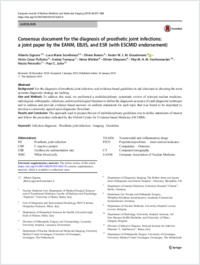Consensus document for the diagnosis of prosthetic joint infections: a joint paper by the EANM, EBJIS, and ESR (with ESCMID endorsement).
- Signore A Nuclear Medicine Unit, Department of Medical-Surgical Sciences and of Translational Medicine, Faculty of Medicine and Psychology, "Sapienza" University of Rome, Rome, Italy. alberto.signore@uniroma1.it.
- Sconfienza LM Unit of Diagnostic and Interventional Radiology, IRCCS Istituto Ortopedico Galeazzi, Milan, Italy.
- Borens O Division of Orthopaedic Surgery and Traumatology, Lausanne University Hospital, Lausanne, Switzerland.
- Glaudemans AWJM Department of Nuclear Medicine and Molecular Imaging, University Medical Center Groningen, University of Groningen, Groningen, The Netherlands.
- Cassar-Pullicino V Department of Diagnostic Imaging, The Robert Jones and Agnes Hunt Orthopaedic and District Hospital - Oswestry, Shropshire, UK.
- Trampuz A Department of Internal Medicine, University Hospital "Charitè", Berlin, Germany.
- Winkler H Osteitis-Centre, Privatklinik Döbling, Vienna, Austria.
- Gheysens O Department of Nuclear Medicine, University Hospital Leuven, Leuven, Belgium.
- Vanhoenacker FMHM Department of Radiology, University Hospital Antwerp, AZ Sint-Maarten Duffel-Mechelen, and University of Ghent, Edegem, Belgium.
- Petrosillo N Division of Infective Diseases, National Institute for Infective Diseases "L. Spallanzani", Rome, Italy.
- Jutte PC Department of Orthopaedic Surgery, University of Groningen, University Medical Center Groningen, Groningen, The Netherlands.
- 2019-01-27
Published in:
- European journal of nuclear medicine and molecular imaging. - 2019
Guideline
Imaging
Infection diagnosis
Prosthetic joint infection
Consensus
Documentation
Europe
Evidence-Based Medicine
Humans
Nuclear Medicine
Prosthesis-Related Infections
Societies, Scientific
English
BACKGROUND
For the diagnosis of prosthetic joint infection, real evidence-based guidelines to aid clinicians in choosing the most accurate diagnostic strategy are lacking.
AIM AND METHODS
To address this need, we performed a multidisciplinary systematic review of relevant nuclear medicine, radiological, orthopaedic, infectious, and microbiological literature to define the diagnostic accuracy of each diagnostic technique and to address and provide evidence-based answers on uniform statements for each topic that was found to be important to develop a commonly agreed upon diagnostic flowchart.
RESULTS AND CONCLUSION
The approach used to prepare this set of multidisciplinary guidelines was to define statements of interest and follow the procedure indicated by the Oxford Centre for Evidence-based Medicine (OCEBM).
For the diagnosis of prosthetic joint infection, real evidence-based guidelines to aid clinicians in choosing the most accurate diagnostic strategy are lacking.
AIM AND METHODS
To address this need, we performed a multidisciplinary systematic review of relevant nuclear medicine, radiological, orthopaedic, infectious, and microbiological literature to define the diagnostic accuracy of each diagnostic technique and to address and provide evidence-based answers on uniform statements for each topic that was found to be important to develop a commonly agreed upon diagnostic flowchart.
RESULTS AND CONCLUSION
The approach used to prepare this set of multidisciplinary guidelines was to define statements of interest and follow the procedure indicated by the Oxford Centre for Evidence-based Medicine (OCEBM).
- Language
-
- English
- Open access status
- hybrid
- Identifiers
-
- DOI 10.1007/s00259-019-4263-9
- PMID 30683987
- Persistent URL
- https://folia.unifr.ch/global/documents/158804
Statistics
Document views: 23
File downloads:
- fulltext.pdf: 0
